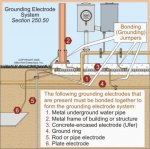jxofaltrds
Retired ESI
- Location
- Mike P. Columbus Ohio
- Occupation
- Creator
Will it's just my opinion but I don't see how decades of installations are suddenly incorrect based on a new interpretation of old code language. Certainly this section has been read millions of times yet no one, including Mike Holt has come to some of the conclusions made in this thread. IMO that would indicate that there is something incorrect in that new interpretation.
I would center on the words sole connection and how they relate to the requirement. IMO they mean that when using plate, rod or pipe eletrodes the GEC need not be larger than #6 Cu. If you were to continue on to another electrode, say a water pipe then you would not have a sole connection to the rod, pipe or plate electrode since the GEC continues to a different electrode.
So what about the "sole connection(s)" in (B) & C)?



